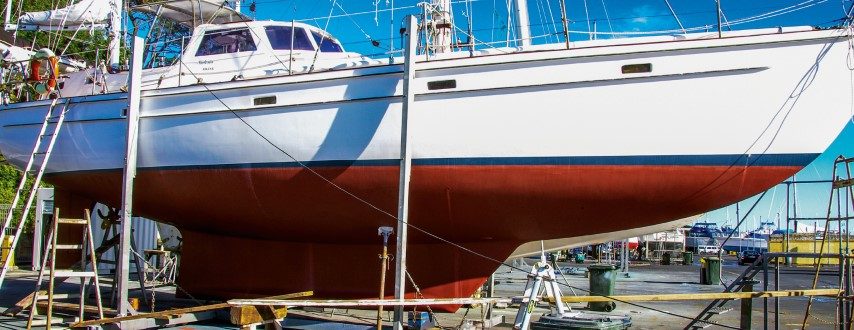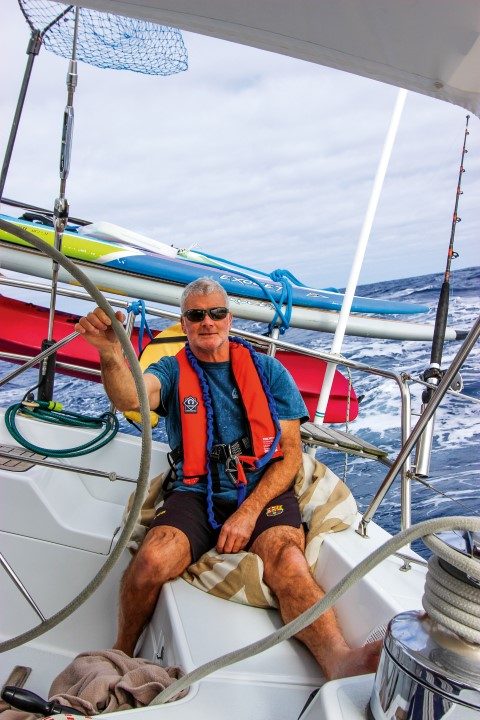

Jim Lott and wife Karin recently returned from a seven-year global cruise. This puts him in a useful place for considering the differences between his first ocean voyage in 1966 and the modern equivalent.
Change is not always obvious. The memory of most weather events fades but we’re nonetheless aware of the increasing frequency and severity of exceptional events, whether it be wind, rainfall, floods or droughts.

Since our departure from New Zealand in 2011 we’ve seen glaciers melting, sea-ice vanishing to allow yachts to transit the Northwest Passage – even ocean currents heading the ‘wrong’ way. Hurricanes and typhoons have always existed, but the maximum wind speeds are increasing.
Higher wind speed is one thing, but the force the wind exerts increases exponentially with greater speed. An obvious result is the spiralling cost of insurance for owners of property on sea and land. So yes, weather conditions have changed – but so have many other components relating to ocean passages.
Yachts, for example.
They’ve become much larger. In the 1970s the ‘ideal’ oceangoing yacht was about 11m. Many are now around 16m. The quest for improved stability (115° is the minimum safe angle for positive righting moment) has seen a marked increase in freeboard. That increases interior volume, which in turn has improved safety thanks to greater reserve buoyancy. A bigger boat handles bigger waves better.

TEL: +44 (0)1243 555561 E.mail: ppl@mistral.co.uk
Web: www.pplmedia.com
And there’s more. Yacht design has been driven by the need for improved comfort, lower building costs, fewer expert man-hours during building and the reduction in the amount of materials. Less material and man-hours equate to lower costs – and lighter weight means faster sailing.
But these developments come with attendant issues. A lower building cost has played into the hands of the charter market whose cast-offs we now see sailing the oceans. What is fine for charter work or coastal sailing is less than ideal for long-term ocean cruising.
Rigs are much lighter with no built-in redundancy if a single component fails. Thirty years ago it was unthinkable that a cruising yacht rig would last less than 10 years. Now it is the norm.
Finding the bottom from time to time is an inevitable part of long-term cruising. A longer keel, with its fore and aft length significantly greater than its depth, provides protection for the hull. Such keels have given way to fin alternatives.

But when a fin keel is deeper than the length of the hull joint, a bump on the bottom concentrates the loads on the hull – with the aft end punching upwards causing severe structural damage and stressing keel bolts. Over recent years we’ve witnessed keels lost while sailing – an event almost unheard of with longer keels. Fin keels don’t protect a hull, but there are advantages: building costs are reduced and performance improves.
Rudders, too, have evolved.
Those that are mounted on a skeg – or on the aft end of the keel – are far less stressed than spade versions. The failure of a spade rudder’s stock leaves a yacht virtually uncontrollable – and some have been abandoned as a result. But spades cost less and perform well. The extra speed of modern yachts suits racing and is more fun on a day-sail – though it makes not an iota of difference on an ocean passage.
THE SAILORS
The profile has changed over the years. Today, those who roam the oceans are often retired, although many families sail the world too. Either way, few cruising yachts are fully-crewed – increasingly reliable autopilots and self-steering systems have replaced people. And that means the skills sailors need have changed over the years.
Until about 1980 every ocean sailor had to master navigating with a sextant, nautical almanac and an accurate time-piece. The arrival of Satnav and then GPS has turned celestial navigation into a dead skill – even charts are now electronic. While there is no doubt electronics have become very reliable, not many sailors have sufficient navigational knowledge to get home if the battery gasps its last.
But on the other hand…
Although navigation may be a lost art, modern sailors need to understand a much wider range of technology if they are to be self-reliant. Electrical systems are far more complex. Electronics are integral to a range of communications equipment. Ironically, understanding this takes more training than using a sextant. Engines, charging systems, hydraulics and refrigeration are fundamental to modern yachts – and the self-sufficient ocean cruiser needs to know a lot more than his counterpart from a few decades ago.

What hasn’t changed is the need to be self-reliant. There have always been sailors who invite others to share their troubles when things go wrong and this is often an easier option because boat servicing is tackled by marina staff at the next port. Preventative maintenance and a comprehensive DIY knowledge are being lost – but these skills have never been more important.
On the positive side of the ledger, safety equipment – such as harnesses and lifejackets – has vastly improved, particularly in regard to preventing accidents and the ability to survive in the water.
COMMUNICATIONS & FORECASTS
Another major area of change. A few decades ago staying in touch relied on a postcard a month from a foreign land with an occasional phone call (usually collect). Now we have instant emails with calls and texts daily to anywhere around the world.
Long-range radios only arrived in the 70s, along with locater beacons. Available resources in life-threatening situations have changed: we used to rely on flares and intermittent short-range radio – we now have EPIRBs and reliable long-range radio with automatic distress messages to summon help.
Weather forecast maps have been around since Robert Fitzroy drew the first isobaric charts 160 years ago. But only in the last 20 years could we rely on predictions a day or two ahead. Previously, you simply sailed when you were ready and accepted the weather that came your way.

In the 1990s the weather fax was a welcome development when at sea. It replaced the daily charts we drew up from morse code signals giving positions, which we joined up with a pencil to make isobaric charts.
Climate information assembled from observations over the years was displayed on ‘Pilot Charts’. These showed seasonal weather patterns and provided ocean sailors with the best time to make passages. We came to expect the seasons to come and go with a level of probability – but climate change has rendered Pilot Charts less useful.
In 2004 New Zealand was first in the world to extend marine forecasts to five days when MetService included the outlook we now have. Since about 2008 we have been blessed with grid charts updated every few hours.

Resolution is now down to an astonishing five-mile grid driven by the world’s most powerful computers. Additionally, we have at least three models to compare – to assess how much we should rely on the prognosis. All are highly reliable for several days and useful to about 10 days. For a modest fee, passage routing for a voyage is now available.
And it’s one of the best dollar-spends a yachtsman can make. Not only can we select the best time to leave on a 1000-mile voyage, we also have enough time for even the slowest cruiser to sail away from the worst storms likely to be encountered on a longer voyage.
The combination of highly accurate detailed weather forecasts along with the ability to receive them on board is the single biggest factor that has decreased the risks associated with ocean sailing in the past 50 years.
In spite of climate change adding to the risks we face as sailors, more and more yachts are making bluewater voyages. And on balance, I’d have to conclude that ocean voyaging has become much safer. We see fewer small craft lost at sea and fewer tragedies where a life is lost.
Changes in technology and design have produced safer yachts in some ways but made them less reliable in others. For sailors today, tackling a bluewater cruise requires different skills.
One crucial factor remains unchanged though: the fundamental requirement to be self-reliant at sea.




